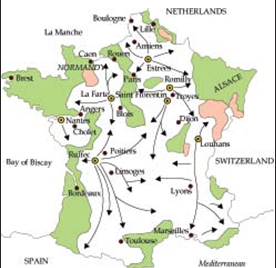
There may also be a financial and social risk if products or raw materials come from countries with lower environmental standards. Increased competition from abroad as a result of trade liberalization creates an incentive for greater efficiency and cheaper production by domestic firms. This competition might also spur a country to shift resources to industries in which it may have a competitive advantage. For example, trade liberalization has encouraged the United Kingdom to concentrate on its service sector rather than manufacturing. Before 1991, the government had imposed various controls on the Indian economy, e.g. industrial licensing systems, price controls, import licences, foreign exchange controls, etc.
The economic reforms that were introduced were aimed at liberalizing the Indian business and industry from all unnecessary controls and restrictions. Liberalization signalled the end of the license permit quota and other restrictions that were put on the industries before 1991. It stresses the integration of domestic economies into a cohesive or interconnected global economy. Foreign Investment Promotion Board (FIPB) was set up to promote foreign investments in India. However, trade liberalization can negatively affect certain businesses within a nation because of greater competition from foreign producers and may result in less local support for those industries.
Key Objectives of Liberalization of India
By the mid-1990s it had gained a stronger place in economic policy. Stakes were sold in the state-owned bank Argentaria, the electricity utility Endesa, the oil company Repsol and the telecommunications company Telefónica. Following the election to office of the right-of-centre PP in 1996 the privatisation programme was accelerated, the objective being to dispose of all state-owned enterprises.At the same time, it was made clear that preference would be given to Spanish capital. In the process of privatisation national champions were created with international reach (Salmon 2001), assisted by the careful preparation of companies before sale and use of their dominant position in the home market after sale. Employment and investment increased both within the major privatised companies and within the sectors in which these companies operated, services improved and prices fell.
In the closing years of the twentieth century Spain took a decisive turn towards liberal capitalism. As recently as the early 1980s, markets had been protected by a battery of import tariffs and non-tariff barriers. Building land was strictly limited by local authority planning controls. There were tight controls on property rental and long minimum rental periods for agricultural land. Labour markets were extremely rigid, making it almost impossible to shed staff.
Economic Reforms in Context of Liberalisation
It refers to integration of the various economies of the world leading towards the emerging of a cohesive or interconnected global economy. It also implies reducing the restrictions on the import and export such as licensing and tariffs. The process of decreasing the state involvement and increasing the market reforms means a process of liberalization .It moves towards the free market or capital economy. After liberalization, investors got the option to invest in a diversified portfolio, thus generating more profit. Therefore, both domestic and international investment grew by a large margin in India. It helps the economy gain momentum due to the active participation of private parties.

The IMF had asked India to adopt the policy of LPG – Liberalisation, Globalisation, and Privatisation. Since then, there have been several structural changes in the Indian economy. Liberalization mainly refers to the upliftment of certain economic policies to bolster economic growth in a country. While initiating liberalization, the government ensures increased participation of private industries and individuals in the economy, thereby strengthening the economy in the long run. It stresses freedom of business and industry from unnecessary controls and restrictions of the government. Proponents of trade liberalization, however, claim that it ultimately lowers consumer costs, increases efficiency, and fosters economic growth.
Impact on the Agricultural Sector
However, as much as the conditions are considered, it may be stated that liberalization has worked well in uplifting the Indian economy. (iii) New private banks were allowed operations, infusing competition into the financial system. The Central Government has abolished FERA (Foreign Exchange Regulation Act) and enacted FEMA (Foreign Exchange Management Act). Under the liberalized exchange management system, value of rupee is determined by the market forces of demand and supply. With a view to ensuring higher productivity and competitive advantage in the international market; the interference of the Government through MRTP was restricted.

(i) Restrictions on operations of foreign banks were eased and new ones were allowed to enter. Exporters are free to sell their foreign currency in the open market; while the importers can freely buy it from the market. Except for these six industries mentioned in the list, all other industries, irrespective of how big investment is involved, have been freed from the provisions of compulsory licensing. The main reasons for the liberalization of India were as mentioned below.
What Is Trade Liberalization?
It refers to transfer of ownership, management and control of the public sector to the private sector. And to achieve this government adopted disinvestment of the public sector and referred the loss making and sick enterprises to the Board of industrial and Financial Reconstruction. Liberalisation means removing all unnecessary controls and restrictions imposed on the economy, such as permits, licences, protectionist consumption quotas, etc. In other words, it is the practice of making laws, systems, or opinions less severe. The economic reform of 1991 in India is an example of the liberalisation of the economy.
- It is the statement of transaction between residents and non residents of the country over a predefined period of time.
- Liberalisation, which had been making inroads into this environment since the 1960s, mainly in terms of international trade, quickened during the 1980s and stepped up a gear in the 1990s.
- It stresses the integration of domestic economies into a cohesive or interconnected global economy.
- For example, trade liberalization has encouraged the United Kingdom to concentrate on its service sector rather than manufacturing.
- There was a significant reduction in the role of public sector enterprises for economic growth.
- Disinvestment of the public sector took place at a significant rate.
It was estimated that between 1980 and 1986 public enterprises accounted for 8 to 10 per cent of the gross value-added of goods and services in Spain (Fariñas, Jaumandreu and Mato, 1989). By 2002 state-owned public enterprises had been reduced to a small number of companies in coal mining, shipbuilding, and certain services notably the post-office, the railways, radio and television, and air and seaport operators. Privatisation began under the Socialist Party (Partido Socialista, PSOE) in the early 1980s as a pragmatic response to industrial problems (Aranzadi 1989).
Protectionism, the opposite of trade liberalization, is characterized by strict barriers and market regulation. The outcome of trade liberalization and the resulting integration among countries is known as globalization. Therefore, economic reforms were introduced in 1991 to loosen restrictions on the economy. Economic reform is based on the assumption that market forces can guide the economy more effectively than government control. Privatization means to drastically reduce the role of the public sector.

(v) Banks and non-banking financial companies have been permitted to enter the insurance business. The Central Government has enacted a new law, the Competition Act, 2002, for upholding competition in the Indian market. The government has removed the industrial licensing requirement from all industries except for a short list of 18 industries; which number has been now reduced to only six industries. (i) Foreign equity participation was raised to 51% for 34 high priority industries.
Apart from trade creation, EU integration led to a concentration of trade within this region. EU trade as a proportion of all trade rose from less than one-third of imports and half of exports in 1980 to some two-thirds of imports and three-quarters of exports. Thus, with the principal exception of agricultural products, in 2002 markets in goods in Spain were relatively open to world competition.
A Creeping Protectionism – Free Press Journal
A Creeping Protectionism.
Posted: Mon, 07 Aug 2023 00:30:00 GMT [source]
Liberalization is an economic concept that mainly refers to reforms to remove certain limiting policies enacted by the government. Liberalization is aimed at growing the economy through increased features of liberalisation participation of private players. Usually, liberalization is initiated by the government to lift restrictions put on trade and businesses to create a transparent and active free-market economy.
For Spain, it would be a particular test of liberalisation policy to open this remaining market and accept market-based reforms to the Common Agricultural Policy (CAP). It was, after all, the largest net recipient of funding through the CAP (Economist 2002a). Labour Market ReformsLabour market reform was the most politically sensitive areas of liberalisation in Spain.


